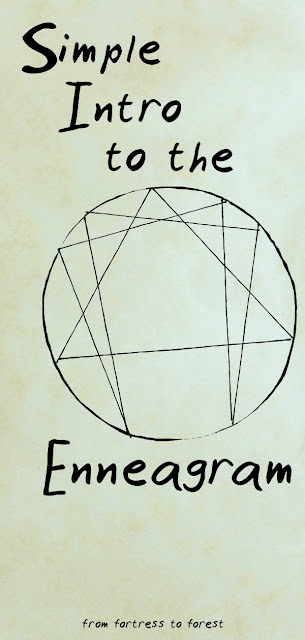A Simple Intro to the Enneagram
The enneagram is a personality typing system. Its greatest strength is its flexibility. With the
enneagram, you can easily zoom in and zoom out of different personalities.
Essentially, the enneagram is as simple or as complex as you want it to be.
- The basis of the system is a circular diagram with lines criss-crossing inside, making nine corners. Thus, 9 personality types, simply numbered 1-9.
- While some people are content with describing themselves as one of the nine types, some prefer to add their wing. A wing is the neighbouring type that has the greatest influence on your personality. Thus, 27 personality types.
- Additionally, there are three basic survival instincts (instinctual variants). At their most primal form, they are self-preservation or sp (the self), sexual or sx (the mate) and social or so (the pack). Everyone uses one more than the others and one less than the others, forming a “stack” (their order of importance). Thus, 6 possibilities which, when combined to the 27 possibilities above, create 162 personality types.
- The 9 personality types are split in three categories (called “centres”): heart, head and body. According to tritype theory, everyone has a preferred type in each centre. These are placed in order of importance and include, or not, a wing. Thus, 4,374 possibilities, or 26,244 personality types once you take in consideration the instinctual variant stack.
- Finally, according to Riso and Hudson, there are 9 levels of health an individual can have, for a grand total of 236,196 possibilities. But these aren’t actual personality types.
Do you see what I mean by “zoom in” (1 in 26,244) and “zoom out” (1 in
9)?
The Enneagram’s Sticky Problem
Sounds fun, right? It’s not. Here’s why:
You find your enneagram type by figuring out which
fear rules your life.
Yeah, it’s not fun. You need to be very honest with yourself…
- 1s fear being imperfect, evil, corrupt.
- 2s fear being unneeded and unloved.
- 3s fear being unworthy losers.
- 4s fear being completely ordinary.
- 5s fear intrusion, being incompetent.
- 6s fear being without guidance.
- 7s fear pain and boredom.
- 8s fear being controlled/harmed.
- 9s fear conflict.
Most people with similar fears cope with them in similar ways:
- 1s become morally rigid perfectionists.
- 2s become as helpful as possible.
- 3s chase success.
- 4s exaggerate their quirks and bad moods.
- 5s withdraw.
- 6s either avoid or confront their fears.
- 7s chase every new, fun-looking thing they see.
- 8s seek power, control, truth.
- 9s become appeasing and self-erasing.
Of course, the wing, the instinctual variant stack and the tritype (all
of which I’ll address further in subsequent posts) will greatly influence the
expression of the personality type. Consider two 4s:
The 4w3 – 8w7 – 6w7 sx/so loves anger, dominance, shock-value,
performance, drama. They are loud and display their emotions for all to see.
The 4w5 – 5w4 – 1w9 sp/sx is quiet, thoughtful, perfectionistic. They
believe they must hide their emotions at all costs and “power through”.
For this reason, behaviour is not solid ground for typing. The enneagram
is about the motivation behind the behaviour, not the behaviour itself. The two
4s above seem very different, but remember that at their core, they are both
motivated by the fear that they could be totally ordinary.
Figuring out your enneagram type requires you to “get real” with
yourself, and this can be very difficult for a wide range of reasons. There are no shortcuts. In a
future post, I’ll give you advice on how to dig through your protective layers.
About the Lines
The lines in the enneagram aren’t completely random. There’s a reason
each number is connected to two other numbers. These lines are called paths of
growth and stress, or integration and disintegration. I’ll give you the theory
first and explain directly after.
- 1s integrate to 7 and disintegrate to 4.
- 4s integrate to 1 and disintegrate to 2.
- 2s integrate to 4 and disintegrate to 8.
- 8s integrate to 2 and disintegrate to 5.
- 5s integrate to 8 and disintegrate to 7.
- 7s integrate to 5 and disintegrate to 1.
- 3s integrate to 6 and disintegrate to 9.
- 9s integrate to 3 and disintegrate to 6.
- 6s integrate to 9 and disintegrate to 3.
Let’s take the 1 as an example. “Integrating to 7” means that when the 1
is secure and healthy, they take on the positive characteristics of 7s. They
are able to loosen up and enjoy life. However, when 1s are insecure and
unhealthy, they “disintegrate to 4”, meaning that they take on the negative
characteristics of 4s. They are moody, dramatic and self-absorbed.
So if you can relate to 9, but not to integrating to 3 (becoming more
goal-oriented in times of growth), maybe 9 is in your tritype (this is called a
“fix”), but not your “main” or “core” type (the first in your tritype,
otherwise known as “your type”).
The Good News
The enneagram tends to focus on what’s wrong with us, but each type
comes with positive traits. The good is there because of the “bad”, and the “bad”
is there because of the good.
The enneagram is a powerful tool to help you grow. Read more about it
here.

Comments
Post a Comment